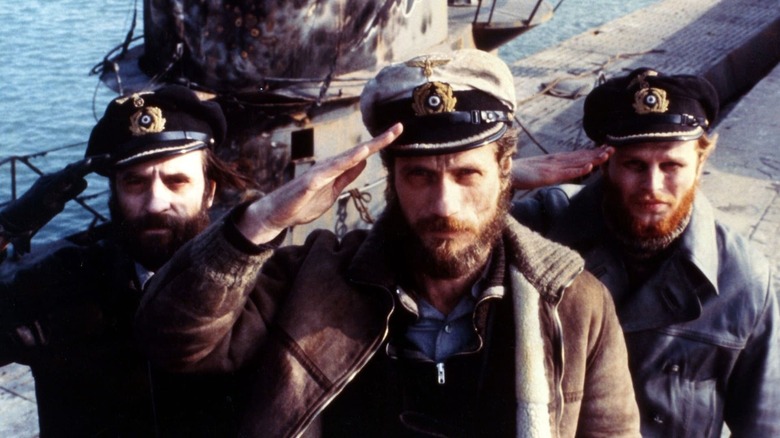Why Das Boot's Author Was Critical Of Its On-Screen Adaptation
Wolfgang Petersen's "Das Boot," based on the 1973 book by Lothar-Günther Buchheim, was an enormous hit when it was released in Germany in 1981. Taking place on the real-life U-96 submarine as it patrolled the oceans during the Battle of the Atlantic in the 1940s, "Das Boot" is a realistic, tense, and action-packed look at the lives of German soldiers as they struggled to survive — both the dangers and the utter tedium — in an extreme environment. It starred Jürgen Prochnow as the submarine's commander, a solider openly critical of the Nazi party and concerned that his crew was too young to handle the pressures of war, though he himself is only 30. "Das Boot" was released in the United States in February of 1982 and would go on to garner six Academy Award nominations, including Best Director.
Like "Blade Runner" before it, "Das Boot" was also subject to multiple recuts. The original German version ran 209 minutes. The version seen in America had been edited down to a mere 149 minutes. Eventually an expanded version was released on TV in England as a miniseries, which included a full 300 minutes, before Petersen finally settled on what would be called "The Director's Cut" in 1997, which brought it back to 208. If you've seen a version of "Das Boot" called "The Original Uncut Version," it is, in fact, a slightly shortened version of the miniseries. It's all clear as mud. Oh, and this is all nothing to say of the 2018 "Das Boot" remake miniseries.
Critics lauded "Das Boot" — Roger Ebert gave the 1997 version four stars, and Janet Maslin was effusive — and it has regularly gone down on lists of the best submarine movies of all time. But the book's original author was upset with the final results. According to Buchheim, the film wasn't historically accurate enough.
Historical realism
"Das Boot" actually came with the imprimatur of its historical accuracy. The real-life soldiers who served on U-96 — Heinrich Lehmann-Willenbrock and Hans-Joachim Krug by name — served as consultants on the film, and Petersen was obsessed with making the submarine's interiors as accurate as possible. Buchheim provided the filmmakers with reference photos of U-96 that he took himself (and were published in his 1976 book "U-Boot-Krieg"), and the sets were built in accordance to them. The exterior of U-96 was a nonfunctional shell that was filmed in the oceans off the coast of France. In a fit of artistic synchronicity, that shell sank during production, and had to be salvaged before shooting could be completed.
Despite the efforts at accuracy, and the struggles of shooting at sea, Buchheim was unsatisfied with little details. Some of his complaints are listed on the website War History Online. Among his quibbles were:
The soldiers, in screaming and crying and behaving the way actors do, were not behaving in a professional manner. Buchheim said that, even as times became stressful, the German seamen remained composed. Indeed, there is a scene wherein a lower-ranking officer throws a greasy rag into the face of his captain. This sort of behavior would not have been attempted on a real U-boat, and the soldier in question would likely have been severely reprimanded.
Petersen, to dramatically depict hull pressure aboard a submarine, filmed bolts flying off the walls in rapid succession. In reality, only one bolt would be enough to cause alarm, as they typically remained in place. Multiple bolts loosening would pretty much spell out certain doom for the people aboard.
The Enigma machine — the infamously difficult-to-crack code-making machine — was a model from 1942 when the film took place in 1941. There are other little details besides, mostly the result of filmmaking continuity rather than historical inaccuracy (like when the actors say they're pointing to port when it's clear they are pointing starboard).
These aren't even Buchheim's greatest complaints, though. He was mostly concerned that "Das Boot" would glorify the German national character irresponsibly and make the Nazis look good. Buchheim's book was explicitly anti-Nazi.
Does "Das Boot" glorify war?
"Das Boot" is not a war propaganda film, and Petersen clearly intends to depict war — especially WWII — as an erosion of the human character. It's about suffering and struggle, not heroism or nationalism.
Regardless, there is a great irony when it comes to depicting combat on camera. Because war is so inherently dramatic — there are two sides fighting with an eventual victor, lives are on the line, and there is a lost of fast movement and violence — any dramatic depiction of it begins to resemble advocacy. If a film is truly about pacifism and stopping war, then violence would not be depicted (see Terrence Malick's 2019 film "A Hidden Life" for an excellent example of that). François Truffaut famously declared this many years ago, and filmmakers have been wrestling with the notion ever since.
Petersen did not want to make a nationalistic film — and to this critic's eye, he didn't — but he is a filmmaker with a flair for the dramatic, and will go out of his way to wring drama from a tense wartime situation. Buchheim was concerned that by showing a U-boat as a place of survival and unity, "Das Boot" would tip into propaganda again. Buchheim was sensitive to that, as he authored propaganda during the war and knew what the real thing looked like.
The sort of exciting visual associated with war on camera are not an issue when describing war on the page. A skilled writer can make sure, with every word, that they disapprove of war, Nazism, and violence. A film doesn't have that convenience, requiring visuals to tell its story. As such, Petersen and Buchheim fell into a conceptual trench that exists between two media. By the end of the film "Das Boot," the sailors are pale, miserable, damp, dead, rueful of the mission and hateful of the political party that made them serve. They have witnessed death, and they despised it.
Whether or not an average audience member thinks "Das Boot" is a glorification of German U-boats in WWII would have to come down to a matter of interpretation.


